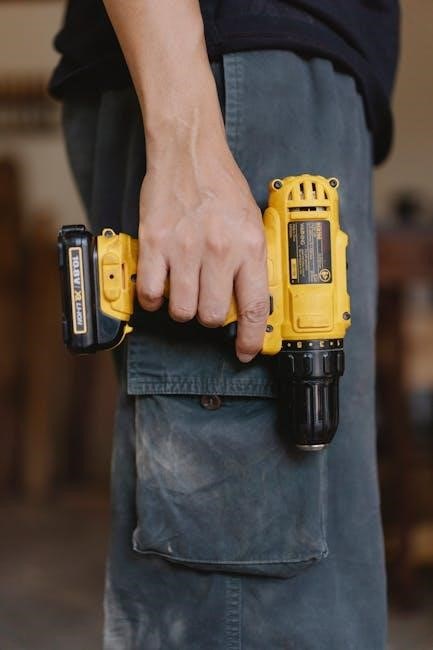A fuel pump manual is a comprehensive guide essential for understanding proper installation, maintenance, and troubleshooting of fuel pump systems. It ensures reliability and efficiency in fuel delivery, covering electric, mechanical, and high-performance pumps. The manual provides step-by-step instructions, safety precautions, and diagnostic techniques, making it indispensable for technicians and vehicle owners. Regular maintenance and correct installation practices outlined in the manual help prevent system failures and ensure optimal vehicle performance. By following the guidelines, users can address common issues and upgrade their fuel systems effectively, ensuring long-term functionality and efficiency.
Overview of Fuel Pump Systems
Fuel pump systems are critical components in modern vehicles, responsible for delivering fuel from the tank to the engine. These systems vary in design, including electric, mechanical, and high-performance configurations. Electric fuel pumps are the most common, offering consistent pressure and reliability, while mechanical pumps are driven directly by the engine. High-performance pumps are designed for vehicles requiring increased fuel flow. A typical system includes the pump, fuel lines, filters, and pressure regulators. Proper installation and maintenance ensure optimal performance, preventing issues like vapor lock or low fuel pressure. The system’s efficiency directly impacts engine performance, making it essential to follow guidelines outlined in fuel pump manuals for troubleshooting and upgrades. Regular servicing and understanding the system’s components are vital for maintaining reliability and efficiency.
Importance of Proper Installation and Maintenance
Proper installation and maintenance of fuel pump systems are crucial for ensuring reliable fuel delivery, optimal engine performance, and preventing potential hazards. Incorrect installation can lead to poor fuel pressure, inefficient engine operation, or even complete system failure. Regular maintenance, such as cleaning filters and inspecting fuel lines, helps prevent contamination and wear, which can degrade performance over time. Additionally, following the guidelines in a fuel pump manual ensures that safety precautions are met, reducing the risk of accidents or damage. Neglecting these steps can result in costly repairs, reduced fuel efficiency, or even engine failure. Proper practices also extend the lifespan of the fuel pump and related components, ensuring long-term functionality and reliability. Always refer to the manual for specific instructions tailored to your vehicle’s fuel system.
Types of Fuel Pumps
Fuel pumps are categorized into electric, mechanical, and high-performance types. Electric pumps offer consistent pressure for modern engines, while mechanical pumps are engine-driven and suited for classic vehicles. High-performance pumps are designed for demanding applications like racing or high-power engines, ensuring superior fuel flow under extreme conditions.
Electric Fuel Pumps
Electric fuel pumps are widely used in modern vehicles due to their efficiency and reliability. They are typically located inside the fuel tank or externally and are powered by an electric motor. These pumps provide consistent fuel pressure, which is crucial for fuel-injected engines. Electric fuel pumps are known for their quiet operation, high flow rates, and ability to maintain pressure even under varying fuel demands. They are compatible with both carbureted and fuel-injected systems, making them versatile for classic cars, trucks, and performance vehicles. Installation requires connecting the pump to a switched ignition source and ensuring proper grounding. Models like the A1000 in-line brushless pump offer advanced features for high-performance applications. Regular maintenance, such as filter replacements, ensures optimal function. Electric fuel pumps are a popular choice for their durability and adaptability to various automotive needs.
Mechanical Fuel Pumps
Mechanical fuel pumps are driven directly by the engine, typically via a camshaft or crankshaft. Unlike electric pumps, they rely on mechanical linkage for operation, making them simpler in design but less adaptable to modern fuel-injected systems. These pumps are commonly found in older vehicles and classic cars, where they provide a reliable, low-cost solution for fuel delivery. Mechanical pumps operate by creating suction to draw fuel from the tank and push it towards the engine. They are known for their durability and minimal electronic components, reducing the risk of electrical failures. However, they may lack the consistent pressure and flow rate required for high-performance applications. Maintenance involves checking diaphragms and valves to ensure proper function. While less common in newer vehicles, mechanical fuel pumps remain a practical choice for specific automotive needs and restorations.
High-Performance Fuel Pumps

High-performance fuel pumps are designed to meet the demands of vehicles requiring increased fuel flow and pressure. These pumps are ideal for racing, turbocharged, or heavily modified engines, where stock pumps may fail to deliver adequate fuel. They feature advanced designs, such as brushless motors, to ensure reliability and efficiency under extreme conditions. High-performance pumps often operate at higher pressures and flow rates, making them suitable for vehicles with high horsepower or those exposed to aggressive driving conditions. They are also durable, with reinforced components to withstand heat and vibration. Proper selection and installation are critical to ensure optimal performance and prevent fuel starvation. These pumps are a must for enthusiasts seeking to maximize their vehicle’s potential, offering superior fuel delivery for enhanced power and consistency.

Installation Procedures
Installation procedures involve disconnecting the battery, removing the fuel tank, and installing the new pump with a gasket. Connect the wiring harness with a fuse and relay kit, ensuring all connections are secure and leak-proof. Follow manufacturer guidelines for torque specifications and proper grounding to avoid electrical issues. Always use appropriate tools like thread seal tape and tubing cutters for precise connections. Proper installation ensures reliable fuel delivery and system performance, while adhering to safety precautions prevents potential hazards. Consult the manual for vehicle-specific instructions to guarantee a successful installation.
Pre-Installation Steps and Safety Precautions
Before installing a fuel pump, disconnect the battery to prevent accidental ignition. Relieve fuel system pressure by removing the fuel cap and allowing the system to vent. Ensure the fuel tank is less than 1/4 full to minimize vapors. Wear protective gear, including gloves and goggles, to avoid injury. Work in a well-ventilated area, away from open flames or sparks, to prevent fire hazards. Use a tubing cutter and flaring kit for precise fuel line connections. Apply thread seal tape to threaded fittings to ensure leak-proof seals. Consult the vehicle’s service manual for specific torque specifications and wiring diagrams. Ground the fuel tank properly to avoid static electricity. Never over-tighten fuel line fittings, as this can damage threads or cause leaks. Follow all safety guidelines to ensure a secure and efficient installation process.
Step-by-Step Installation Guide
- Remove the old fuel pump by disconnecting the fuel lines, electrical connectors, and mounting brackets. Drain the fuel tank if necessary.
- Inspect and clean the fuel tank and surrounding area to prevent contamination. Install the new fuel pump assembly, ensuring the strainer is securely attached.
- Reconnect the fuel lines, making sure all connections are tight and leak-proof. Use thread seal tape for threaded fittings.
- Connect the electrical wires, ensuring the positive lead is linked to a switched ignition source with a fuse. Ground the negative lead to a clean chassis.
- If using a relay, install it according to the manufacturer’s instructions to handle the increased current load.
- Reinstall the fuel tank and replace the fuel filter. Fill the tank with clean fuel and check for leaks.
- Test the system by turning the ignition on and listening for the pump’s hum. Start the engine to ensure proper fuel flow.
- Refer to the service manual for specific torque and wiring details to ensure a correct and safe installation.
Use a tubing cutter and flaring kit for precise fuel line connections, and ensure all steps are followed carefully to avoid system damage.

Maintenance and Troubleshooting
Regular inspection of fuel pumps ensures optimal performance. Check for worn components, clean filters, and inspect wiring. Common issues include faulty fuses, malfunctioning relays, or low fuel pressure.

- Test fuel pump voltage and resistance using a multimeter.
- Replace clogged fuel filters to maintain proper flow.
- Inspect fuel lines for leaks or damage.
- Consult the manual for specific diagnostic codes and solutions.
Routine Maintenance for Fuel Pumps
Regular maintenance is crucial to ensure the longevity and efficiency of fuel pumps. Start by inspecting the fuel pump fuse and relay to ensure proper electrical connections. Check the fuel filter and replace it if clogged, as dirty filters can restrict fuel flow. Inspect fuel lines for leaks or damage and clean or replace them as needed. Use a multimeter to test the fuel pump’s voltage and resistance, ensuring it matches the specifications in the manual. Additionally, monitor fuel pressure using a pressure gauge to detect any deviations from the recommended level. Clean the fuel tank periodically to remove contaminants and sediment that could damage the pump. Replace worn-out components like the fuel strainer or O-rings to maintain a tight seal. Regular servicing helps prevent unexpected failures and ensures consistent fuel delivery to the engine.
Common Issues and Diagnostic Techniques
Common issues with fuel pumps include low fuel pressure, contaminated fuel, and electrical faults. Diagnosing these problems often starts with checking the fuel pump fuse and relay for proper function. A voltage drop test can identify wiring issues, while listening for unusual noises can indicate a failing pump. Faulty pressure regulators or clogged fuel filters may also mimic pump failure. Using a multimeter, technicians can test the pump’s power supply and ground connections. Visual inspections of fuel lines and connections help detect leaks or corrosion. If the pump is in-tank, ensuring the fuel level is adequate for proper operation is crucial. Diagnostic techniques outlined in the manual guide technicians through systematic troubleshooting to isolate and resolve issues efficiently, ensuring accurate repairs and preventing further system damage.
Tools and Materials Required for Servicing
Servicing a fuel pump requires specific tools and materials to ensure safe and effective repairs. Essential tools include a multimeter for diagnosing electrical issues, a tubing cutter and flaring kit for fuel line modifications, and a pressure test kit to verify system integrity. A drain pan is necessary for catching fuel during tank draining, while gloves and safety goggles protect against hazards. Materials needed include thread seal tape for preventing leaks, replacement gaskets or O-rings for sealing connections, and a fuel line cleaner to remove contaminants. For in-tank pumps, a pump module installation tool may be required. Always refer to the fuel pump manual for specific recommendations, as some pumps may need specialized tools like a fuel pressure test gauge. Proper tools and materials ensure accurate diagnostics and reliable repairs, maintaining fuel system performance and safety.
Performance Enhancement and Upgrades
Upgrading to high-pressure fuel pumps and aftermarket accessories enhances fuel flow and pressure, improving engine performance, especially in high-demand applications like racing or heavy-duty vehicles.
Upgrading to High-Pressure Fuel Pumps
Upgrading to a high-pressure fuel pump enhances fuel delivery for high-performance applications, ensuring consistent flow under increased demand. Models like the A1000 in-line brushless pump offer superior reliability and efficiency. Installation requires careful selection of the correct pump for your vehicle’s specifications. Proper grounding and wiring, including a 30-amp relay, are essential for optimal performance. Always follow the manufacturer’s instructions for installation and ensure all connections are secure. Regular maintenance, such as cleaning filters and checking for voltage drop, is crucial to prevent issues. High-pressure pumps are ideal for racing, turbocharged engines, or vehicles needing increased fuel flow. Upgrading ensures your fuel system meets the demands of your engine, delivering power and efficiency when it matters most.
Installing Aftermarket Fuel Pump Accessories
Installing aftermarket fuel pump accessories can significantly enhance your vehicle’s performance and fuel efficiency. These accessories, such as high-flow fuel filters, pressure regulators, and upgraded wiring kits, ensure a consistent fuel supply. When installing, follow the manufacturer’s guidelines to avoid system damage. Proper wiring, including a relay kit, is essential for high-performance pumps. Accessories like marine-grade pumps or dual-tank systems offer tailored solutions for specific applications. Always check compatibility with your vehicle’s make and model. For example, a brushless in-line pump like the A1000 is ideal for racing or high-demand scenarios. Ensure all connections are leak-proof and securely fastened. Upgrading your fuel system with aftermarket components can deliver improved power, reliability, and durability, making it a worthwhile investment for enthusiasts and professionals alike.





























































